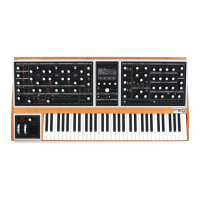10
VOICE ARCHITECTURE (Continued)
Hard Sync is available on Oscillator 2 and Oscillator 3, with Oscillator 1 being the default source of sync.
Oscillator-derived ring modulation, a multi-mode noise generator, and external audio signals are also
available as sound sources. In the Mixer module, each sound source can be routed to either a pair of
State Variable Filters (SVF), the Ladder Filter, or both. The SVF and Ladder lters can operate in series or
parallel with one another, while a dedicated MIX knob species the output balance between Filters.
In addition, each Synth also has access to four Low Frequency Oscillators (LFO) and three Envelope
Generators (EG) per-voice, each equipped with a wealth of extended functions that greatly expand
the synthesis capabilities of Moog One. Commonly used modulation routings are hardwired through
dedicated front-panel controls. Further assignments can easily be made via the DEST buttons located
within each LFO and Envelope module.
From the central LCD panel, modulation routings can be tweaked and reassigned using the vast potential
of the Modulation Matrix. Assignments can stand alone, or can be mapped through a controller (such as
the MOD WHEEL, X/Y PAD, and AFTERTOUCH). Assignable modulation modiers called Transforms
can also be utilized to morph the source signal, providing even greater creative control over modulation.
PILOTING MOOG ONE
As with the Minimoog and Memorymoog before it, Moog One features an angled control panel for
improved visibility and ease of operation. This Front Panel provides immediate access to the Moog One
sound engine and all of its synthesis parameters. Below the Front Panel you will nd an ultra-playable
61-note velocity-sensitive keyboard with aftertouch, and an expressive Left Hand Controller that
further extends the dynamic playability of this powerful analog instrument. Around back, the Moog
One Rear Panel is home to a vast array of audio, analog control voltage, and expression input and
output jacks, as well as MIDI, USB, and Ethernet ports.
FRONT PANEL
The Front Panel is divided into three sections – the Left Panel, the Center Console, and the Right Panel.
The Front Panel is always active, in that turning a knob or pressing a button will have an immediate
effect. Because Moog One is a fully programmable instrument, however, the position of the Front Panel
knobs and buttons will rarely match their currently loaded values. The exceptions are the MASTER
VOLUME and HEADPHONES knobs, which are unaffected by the loading of Presets and Timbres.
NOTE: The response behavior of the Front Panel knobs can be specied using the HARDWARE settings
in the GLOBAL menu.
LEFT AND RIGHT PANEL CONTROLS
The Left and Right Panels are populated with dedicated single-function hardware knobs and buttons
that offer immediate control of the Moog One sound engine. These controls are grouped together by
module, and modules are grouped together by type. Contained in the Left Panel are the Oscillators,
Low Frequency Oscillators (LFO), Noise Generator, Ring Modulator, Arpeggiator, Sequencer, Master
Clock, Chord, and Polyphony modules. A distinctive feature of each Oscillator module is the dedicated
OLED window, which provides a graphic representation of the composite waveform being output to
the Mixer. Contained in the Right Panel are the Mixer, State Variable Filters, Ladder Filter, Envelope
Generators (EG), VCA, and Output modules. Also found in the Right Panel are the Synth Effect
parameters and the Master Effect sends, which provide access to numerous studio-grade effects,
including acclaimed reverbs from Eventide®.
With the exception of the MASTER VOLUME, HEADPHONES, and MASTER CLOCK controls, all of the
parameters available on the Left and Right Panels will control the currently selected Synth(s) only.

